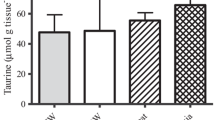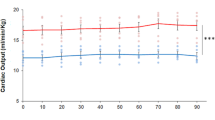Abstract
Pacific hagfish, Eptatretus stoutii, can recover from 36 h of anoxia and their systemic hearts continue to work throughout the exposure. Recent work demonstrates that glycogen stores are utilized in the E. stoutii heart during anoxia but that these are not sufficient to support the measured rate of ATP production. One metabolic fuel that could supplement glycogen during anoxia is glycerol. This substrate can be derived from lipid stores, stored in the heart, or delivered via the blood. The purpose of this study was to determine the effect of glycerol on the contractile function of the excised E. stoutii heart during anoxia exposure. When excised hearts, perfused with metabolite free saline (mf-saline), were exposed to anoxia for 12 h, there was no difference in heart rate, pressure generation (max-dP), rate of contraction (max-dP/dtsys), or rate of relaxation (max-dP/dtdia) compared to hearts perfused with mf-saline in normoxia. However, hearts perfused with saline containing glycerol (gly-saline) in anoxia had higher max-dP, max-dP/dtsys, and max-dP/dtdia than hearts perfused with mf-saline in anoxia. Tissue levels of glycerol increased when hearts were perfused with gly-saline in normoxia, but not when perfused with gly-saline in anoxia. Anoxia exposure did not affect the activities of triglyceride lipase, glycerol kinase, or glycerol-3-phosphate dehydrogenase. This study suggests that glycerol stimulates cardiac function in the hagfish but that it is not derived from stored lipids. How glycerol may stimulate contraction is not known. This could be as an energy substrate, as an allosteric factor, or a combination of the two.






Similar content being viewed by others
References
Areta JL, Hopkins WG (2018) Skeletal muscle glycogen content at rest and during endurance exercise in humans: a meta-analysis. Sports Med. https://doi.org/10.1007/s40279-018-0941-1
Bergmeyer HU, Bergmeyer Jr, Grassl M (1983) Methods of enzymatic analysis, 3rd edn. Verlag Chemie, Weinheim
Bucking C, Glover CN, Wood CM (2011) Digestion under duress: nutrient acquisition and metabolism during hypoxia in the Pacific hagfish. Physiol Biochem Zool 84(6):607–617. https://doi.org/10.1086/662630
Cox GK, Sandblom E, Farrell AP (2010) Cardiac responses to anoxia in the Pacific hagfish, Eptatretus stoutii. J Exp Biol 213(21):3692–3698. doi:https://doi.org/10.1242/Jeb.046425
Cox GK, Sandblom E, Richards JG, Farrell AP (2011) Anoxic survival of the Pacific hagfish (Eptatretus stoutii). J Comp Physiol B Biochem Syst Environ Physiol 181(3):361–371. https://doi.org/10.1007/s00360-010-0532-4
Crabtree B, Newsholme EA (1972) The activities of phosphorylase, hexokinase, phosphofructokinase, lactate dehydrogenase and the glycerol 3-phosphate dehydrogenases in muscles from vertebrates and invertebrates. Biochem J 126(1):49–58
Cutler CP (2006) Cloning of an aquaporin 9 gene orthologue from the hagfish (Myxine glutinosa). Bull Mt Desert Isl Biol Lab 45:42–43
Dhar-Chowdhury P, Harrell MD, Han SY, Jankowska D, Parachuru L, Morrissey A, Srivastava S, Liu W, Malester B, Yoshida H, Coetzee WA (2005) The glycolytic enzymes, glyceraldehyde-3-phosphate dehydrogenase, triose-phosphate isomerase, and pyruvate kinase are components of the K(ATP) channel macromolecular complex and regulate its function. J Biol Chem 280(46):38464–38470. https://doi.org/10.1074/jbc.M508744200
Driedzic WR, Ewart KV (2004) Control of glycerol production by rainbow smelt (Osmerus mordax) to provide freeze resistance and allow foraging at low winter temperatures. Comp Biochem Physiol B Biochem Mol Biol 139(3):347–357. https://doi.org/10.1016/j.cbpc.2004.04.007
Driedzic WR, West JL, Sephton DH, Raymond JA (1998) Enzyme activity levels associated with the production of glycerol as an antifreeze in liver of rainbow smelt (Osmerus mordax). Fish Physiol Biochem 18(2):125–134. https://doi.org/10.1023/A:1007777501093
Farrell AP, Smith F (2017) Cardiac form, function and physiology. In: Gamperl A, Gillis TE, Farrell AP, Brauner CJ (eds) The cardiovascular syste, form function and control, vol 36A. Elsivier: New York pp 155–264
Farrell A, Gamperl A, Hicks J, Shiels H, Jain K (1996) Maximum cardiac performance of rainbow trout (Oncorhynchus mykiss) at temperatures approaching their upper lethal limit. J Exp Biol 199(Pt 3):663–672
Forster ME, Axelsson M, Farrell AP, Nilsson S (1991) Cardiac-function and circulation in hagfishes. Can J Zool 69(7):1985–1992. doi:https://doi.org/10.1139/Z91-277
Gambert S, Helies-Toussaint C, Grynberg A (2007) Extracellular glycerol regulates the cardiac energy balance in a working rat heart model. Am J Physiol Heart Circ Physiol 292(3):H1600–H1606. https://doi.org/10.1152/ajpheart.00563.2006
Gillis TE, Regan MD, Cox GK, Harter TS, Brauner CJ, Richards JG, Farrell AP (2015) Characterizing the metabolic capacity of the anoxic hagfish heart. J Exp Biol 218:3754–3761. https://doi.org/10.1242/jeb.125070
Graham MS, Farrell AP (1989) The effect of temperature acclimation and adrenaline on the performance of a perfused trout heart. Physiol Zool 62:38–61
Hansen CA, Sidell BD (1983) Atlantic hagfish cardiac muscle: metabolic basis of tolerance to anoxia. Am J Physiol 244:R356–R362
Herr JE, Clifford AM, Goss GG, Fudge DS (2014) Defensive slime formation in Pacific hagfish requires Ca2+- and aquaporin-mediated swelling of released mucin vesicles. J Exp Biol 217(Pt 13):2288–2296. https://doi.org/10.1242/jeb.101584
Hibuse T, Maeda N, Nakatsuji H, Tochino Y, Fujita K, Kihara S, Funahashi T, Shimomura I (2009) The heart requires glycerol as an energy substrate through aquaporin 7, a glycerol facilitator. Cardiovasc Res 83(1):34–41. https://doi.org/10.1093/cvr/cvp095
Icardo JM, Colvee E, Schorno S, Lauriano ER, Fudge DS, Glover CN, Zaccone G (2016) Morphological analysis of the hagfish heart. I. The ventricle, the arterial connection and the ventral aorta. J Morphol 277(3):326–340. https://doi.org/10.1002/jmor.20498
Inui Y, Yu JY, Gorbman A (1978) Effect of bovine insulin on the incorporation of [14C]glycine into protein and carbohydrate in liver and muscle of hagfish, Eptatretus stouti. General Comp Endocrinol 36(1):133–141
Johansen KL (1960) Circulation in the hagfish, Myxine glutinosa. Biol Bull, 118:298
Klaiman JM, Pyle WG, Gillis TE (2014) Cold acclimation increases cardiac myofilament function and ventricular pressure generation in trout. J Exp Biol 217(Pt 23):4132–4140. https://doi.org/10.1242/jeb.109041
Martini FH (1998) The ecology of hagfishes. In: Jørgensen JM, Lomholt JP, Weber RE, Malte H (eds) Biology of hagfishes. Springer Nature, Switzerland, pp 57–77
Mendonca PC, Genge AG, Deitch EJ, Gamperl AK (2007) Mechanisms responsible for the enhanced pumping capacity of the in situ winter flounder heart (Pseudopleuronectes americanus). Am J Physiol Regul Integr Comp Physiol 293(5):R2112–R2119. https://doi.org/10.1152/ajpregu.00202.2007
Perez-Jimenez A, Hidalgo MC, Morales AE, Arizcun M, Abellan E, Cardenete G (2009) Use of different combinations of macronutrients in diets for dentex (Dentex dentex): effects on intermediary metabolism. Comp Biochem Physiol A Mol Integr Physiol 152(3):314–321. https://doi.org/10.1016/j.cbpa.2008.11.002
Robertson JD (1976) Chemical composition of body-fluids and muscle of hagfish Myxine-glutinosa and rabbit-fish Chimaera-monstrosa. J Zool 178(Feb):261–277
Ryan NM (1996) Subcellular fractionation of animal tissues. Methods Mol Biol 59:49–56. https://doi.org/10.1385/0-89603-336-8:49
Satchell GH (1991) Physiology and form of fish circulation. Cambridge University Press, Cambridge
Sidell BD, Beland KF (1980) Lactate dehydrogenases of Atlantic hagfish: physiological and evolutionary implications of a primitive heart isozyme. Science 207(4432):769–770
Treberg JR, Wilson CE, Richards RC, Ewart KV, Driedzic WR (2002) The freeze-avoidance response of smelt Osmerus mordax: initiation and subsequent suppression of glycerol, trimethylamine oxide and urea accumulation. J Exp Biol 205(10):1419–1427
van der Vusse GJ, Glatz JF, Stam HC, Reneman RS (1992) Fatty acid homeostasis in the normoxic and ischemic heart. Physiol Rev 72(4):881–940
Wakayama JE, Swanson JR (1977) Ultraviolet spectrometry of serum triglycerides by a totally enzymic method adapted to a centrifugal analyzer. Clin Chem 23(2 PT. 1):223–228
Walsh PJ, Foster GD, Moon TW (1983) The effects of temperature on metabolism of the American eel Anguilla-rostrata (Lesueur)—compensation in the summer and torpor in the winter. Physiol Zool 56(4):532–540. doi:https://doi.org/10.1086/physzool.56.4.30155876
Wilson CM, Roa JN, Cox GK, Tresguerres M, Farrell AP (2016) Introducing a novel mechanism to control heart rate in the ancestral Pacific hagfish. J Exp Biol 219(Pt 20):3227–3236. https://doi.org/10.1242/jeb.138198
Wittels B, Spann JF Jr (1968) Defective lipid metabolism in the failing heart. J Clin Investig 47(8):1787–1794. https://doi.org/10.1172/JCI105868
Young DA, King DS, Chen M, Norris B, Nemeth PM (1988) A novel method for measurement of triglyceride lipase activity: suitable for microgram and nanogram quantities of tissue. J Lipid Res 29:527–532
Acknowledgements
The Authors would like to thank C.R. Freedman and Dr. D.S. Fudge for comments on an earlier draft, as well as Dr. I. Lorenzen-Schmidt and A. Pierce for technical assistance.
Funding
This work was supported by an operating grant from the Canadian Institutes of Health Research to W.G.P, and a Discovery Grant, and Discovery Accelerator Supplement, from the National Sciences and Engineering Research Council of Canada to T.E.G.
Author information
Authors and Affiliations
Corresponding author
Additional information
Communicated by H. V. Carey.
Publisher’s Note
Springer Nature remains neutral with regard to jurisdictional claims in published maps and institutional affiliations.
Rights and permissions
About this article
Cite this article
Gatrell, L.A., Farhat, E., Pyle, W.G. et al. Contractile function of the excised hagfish heart during anoxia exposure. J Comp Physiol B 189, 199–211 (2019). https://doi.org/10.1007/s00360-019-01208-w
Received:
Revised:
Accepted:
Published:
Issue Date:
DOI: https://doi.org/10.1007/s00360-019-01208-w




